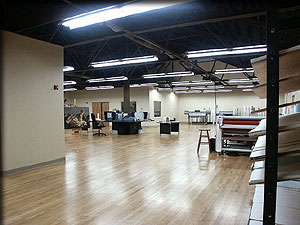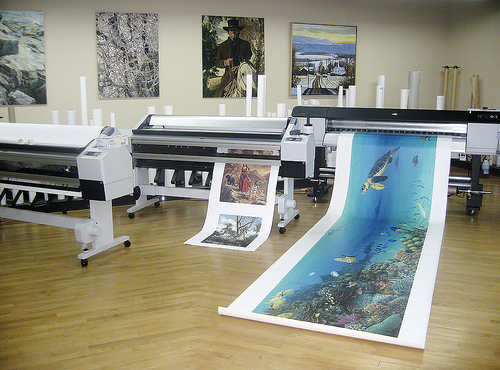
The number of studios using wide-format, pigment-ink inkjet printers for fine-art reproduction has multiplied in recent years. Having more choices can be wonderful if you simply want to make a few copies of work that you can sell at art fairs, use to promote yourself, or give to friends and family members.
But if you have special requirements such as extra-large print sizes or need hundreds of prints quickly, it’s important to know about giclée-printing studios that can efficiently produce the best possible reproductions. Significant differences exist in the type of image-capture and inkjet-printing equipment that various studios use for giclée printing. And some studio owners are more experienced in the world of art than others.
One company well-equipped to handle just about any type or size of art-reproduction project you might require is Lizza Fine Art Studios. Located in the small town of Tunkhannock in northeastern Pennsylvania, Lizza Fine Art Studios has handled projects for artists from as far away as South Africa, including artists who exhibit at the International Artexpo in New York each spring.
The studio’s founder Bob Lizza knows what matters to artists, because he is a painter himself. He also has an eye for color honed by graphic design and close to 20 years of experience in the print world. For Bob, giclée is more than a printing process; it the intersection of art and science—an act of creation leading to a work of art.

Scanning Large Paintings: Because Lizza knows that every brush stroke and detail is important to the artistic integrity of a painting, he invested in the Cruse C285 ST scanner, one of the most technologically advanced, highest resolution scanners in the world. When a painting is placed on the bed of the scanner, a Synchron table system moves the art steadily under a bank of lights, providing even illumination as the image is captured using a large-format digital lens and a 10,000-pixel CCD array. The system was designed to minimize the amount of time the original painting is exposed to the levels of lighting needed to capture all the fine details in the art.
The Cruse C285 ST scanner can handle paintings as large as 60 in. x 90 in. in one pass and produce files sizes as large as 1 GB. Due to the efficiency of the lighting system and precision of the Synchron table, much larger originals can be accommodated. Positional lighting allows total control over how variances in textured surfaces can be captured.
Printing Large Jobs: Lizza Fine Art Studios has two 64-in. Epson Stylus Pro printers: an Epson Stylus Pro 11880 aqueous-ink printer and an Epson Stylus Pro GS6000 solvent-ink printer. Because it uses three densities of black inks, the Epson Stylus Pro 11880 is ideal for black-and-white photographs and images with subtle midtones. The Epson Stylus Pro GS6000 uses orange and green inks in combination with traditional CMYK inks, making it possible to reproduce artwork with bold, vivid colors. Because of the nature of the solvent inks, the GS6000 printer can print on less costly materials and run at faster speeds. Plus, the prints don’t require the additional step of adding a protective clearcoat. Thus, the Epson GS6000 can be used to produce higher quantities of art reproductions at more affordable prices.
An Eye for Color: No matter which printer is used to reproduce your work, Lizza knows how to achieve the best possible color match between the prints and your original art. Bob Lizza has spent more than 17 years scanning and matching originals, examining images on a computer monitor and managing colors that have been reduced to bits and bytes of data. Combining data gathered with high-quality color-measurement tools and his own eye for color, Bob can color match the vibrant red of an individual flower petal or the rich green in the eye of the trout. If his naked eye sees any differences, such as greens that are just a shade too yellow, he knows how to adjust the colors until the match between the scanned image and the artwork is exact. Only when the color match is perfect is Bob ready to print. He creates custom ICC profiles for the exact printing conditions and materials that will be used for your printing job. He knows how to adjust the profiles for precise, optimum control of the ink applied to the substrate.
After the Printing is Done: Lizza’s extreme attention to detail and service doesn’t end with the printing. For works printed on canvas, Lizza Fine Art Studios uses a spray system that provides a great deal of control over the varnishing process. They can lightly coat the print once, or apply two or three coats if you prefer a glossier look.
Lizza Fine Art Studio also provides custom-framing services. And if you request it, Lizza will issue a certificate of authenticity. The certificate not only assures buyers of your art that the piece is a genuine, limited-edition giclée, it also ensures that you have a record of what was printed, what substrate was used, the date it was printed, and how many pieces were produced.
As an artist himself, Bob Lizza believes that modern giclée printing is the best possible way to reproduce your original art. He points out that, “It has a higher resolution than lithography, and a wider color range than a serigraph.”
To learn more about Lizza Fine Art Studios, visit their website www.lizzastudios.com or call 570-836-8806. Or, you can read more about their work in the June issue of LexJet’s In Focus newsletter.

Fine-art printmaking studios across the US have purchased wide-format inkjet equipment and top-quality canvases and fine-art papers from LexJet. We will feature many of these other studios in upcoming posts on this blog. If you would like to locate a giclee printing studio in your area of the US, please call a LexJet account specialist at 888-873-7553.
